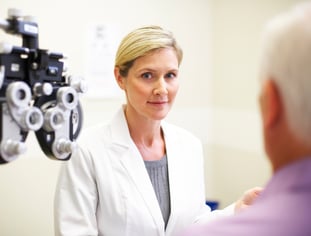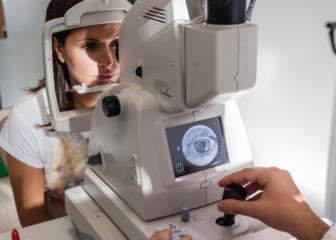Discovering the current Technological Developments in Optometry and What They Mean for Optometrists
From the accuracy of Optical Comprehensibility Tomography to the nuanced insights used by AI-driven diagnostic tools, these innovations are establishing brand-new requirements in individual assessment and therapy. As these improvements permeate the technique, optometrists are faced with the difficulty of accepting these tools to boost client results.
Innovations in Diagnostic Devices
Progressing the field of optometry, advancements in analysis tools have revolutionized the method eye care experts examine and detect eye problems and aesthetic disabilities. The previous decade has experienced substantial technological developments, making it possible for even more extensive and exact assessments. Optical Comprehensibility Tomography (OCT), as an example, gives high-resolution cross-sectional images of the retina, enabling the very early discovery of illness such as glaucoma and age-related macular deterioration. This non-invasive imaging strategy has actually ended up being crucial in contemporary optometric technique.
An additional secret technology is the introduction of innovative corneal topography systems, which map the surface area curvature of the cornea with precision. These tools are specifically advantageous for fitting call lenses and diagnosing corneal disorders. Digital retinal imaging has transformed traditional ophthalmoscopy, providing comprehensive, breathtaking views of the retina that assist in comprehensive aesthetic exams.
The advancement of wavefront aberrometry has actually additionally been crucial, allowing the analysis of refractive errors with unequaled precision (Eye Doctor). This innovation assists in tailoring restorative lenses and enhancing surgical outcomes for refractive surgeries. Collectively, these diagnostic improvements empower optometrists to deliver superior patient care, ensuring early treatment and customized treatment techniques, eventually enhancing visual health results
AI in Individual Monitoring
Building on the foundation of sophisticated analysis devices, the unification of artificial intelligence (AI) in individual monitoring stands for a transformative jump for optometry. AI systems are significantly utilized to improve effectiveness, precision, and personalization in person care.
In addition, AI-driven platforms facilitate structured person interactions and management processes. Automated scheduling, digital examinations, and personalized follow-up strategies not only enhance patient satisfaction but additionally enhance time administration for professionals. These systems can triage people based upon the urgency of their conditions, making certain that those in vital demand receive timely attention.
Furthermore, AI enhances decision-making by giving optometrists with evidence-based recommendations and therapy pathways. By integrating data from digital wellness documents, AI devices offer insights that notify professional choices, decreasing the danger of mistakes and boosting client results. As AI remains to develop, its function in client administration will likely expand, reshaping the landscape of optometric treatment.
Developments in Retinal Imaging
In the realm of optometry, retinal imaging has actually witnessed remarkable technological innovations that are improving analysis abilities and client care. Technologies such as Optical Coherence Tomography (OCT) and fundus photography have actually transformed exactly how eye doctors assess the retina and visualize. OCT, particularly, supplies high-resolution, cross-sectional images of the retina, enabling for the thorough exam of its layers. This capacity is very useful for very early detection and administration of conditions like glaucoma, diabetic retinopathy, and age-related macular degeneration.
Enhanced imaging modalities like OCT angiography are further refining diagnostic precision. This non-invasive technique maps blood flow in the retina, supplying important understandings right into vascular health without the demand for color injections. In addition, adaptive optics modern technology is being incorporated right into retinal imaging systems to remedy ocular aberrations, providing unprecedented picture clarity. Such improvements help with the recognition of min retinal changes that can represent condition progression.
Additionally, developments in synthetic intelligence are enhancing retinal imaging by enabling automatic evaluation of huge datasets. These systems aid eye doctors in identifying patterns indicative of pathology, thereby improving analysis precision and performance. Jointly, these developments are changing retinal imaging right into a keystone of modern eye care, improving outcomes and broadening healing opportunities.
Teleoptometry's Expanding Duty
Teleoptometry is progressively ending up being an essential component of eye treatment, driven by innovations in data and analysis devices. As optometry welcomes electronic makeover, teleoptometry facilitates remote assessments, permitting eye doctors to expand their solutions beyond conventional limits. This is specifically valuable in country and underserved areas where accessibility to specialized eye care is hop over to these guys commonly restricted. By leveraging high-resolution video clip conferencing and progressed retinal imaging, eye doctors can perform thorough eye tests from afar, making certain prompt medical diagnosis and therapy.
The integration of synthetic knowledge (AI) additional enhances teleoptometry, making it possible for the analysis of aesthetic data and aiding in the discovery of ocular problems such as glaucoma and diabetic retinopathy. AI-powered algorithms can swiftly analyze complicated imaging information, supplying optometrists with useful insights that boost medical decision-making.
In addition, teleoptometry supports connection of care via seamless combination with electronic health and wellness records (EHRs), enabling optometrists to keep detailed individual histories. When consulting with various practitioners., this makes sure that clients receive individualized and regular treatment also.
Regardless of these benefits, difficulties remain, including guaranteeing data safety and security and taking care of client expectations. Teleoptometry represents a considerable stride towards more obtainable, reliable, and patient-centered eye care. As modern technology evolves, its function is poised to broaden additionally.

Future Fads in Eye Treatment
A myriad of cutting-edge fads is established to improve the future of eye treatment, driven by technological improvements and the progressing requirements of individuals. One substantial trend is the integration of artificial knowledge (AI) in diagnostics, which assures to improve the precision and efficiency of eye evaluations. AI algorithms can assess substantial quantities of data from retinal pictures, potentially visit our website detecting conditions like diabetic person retinopathy and glaucoma earlier than typical approaches.
In addition, personalized medicine is gaining traction in optometry, with genetic testing informing customized therapy strategies. This strategy intends to enhance person outcomes by customizing interventions to individual hereditary profiles. Wearable technology, such as wise contact lenses, is additionally on the perspective, providing real-time surveillance of intraocular pressure or sugar levels, thus giving constant insights right into ocular and systemic health.
The fostering of enhanced fact (AR) and online reality (VR) in training and individual education and learning is one more emerging fad. These modern technologies offer immersive experiences that can enhance understanding and skills both for eye doctors and people. As these fads develop, eye useful source doctors must stay abreast of technical developments to supply cutting-edge treatment, making sure enhanced individual results and contentment in the dynamic landscape of eye treatment.
Verdict

Collectively, these diagnostic improvements encourage eye doctors to supply premium patient care, making certain very early intervention and tailored therapy strategies, inevitably boosting aesthetic health results.

As these technologies proceed to develop, eye doctors need to adapt and include them right into practice, inevitably enhancing operations effectiveness and boosting the standard of eye treatment delivered to individuals.